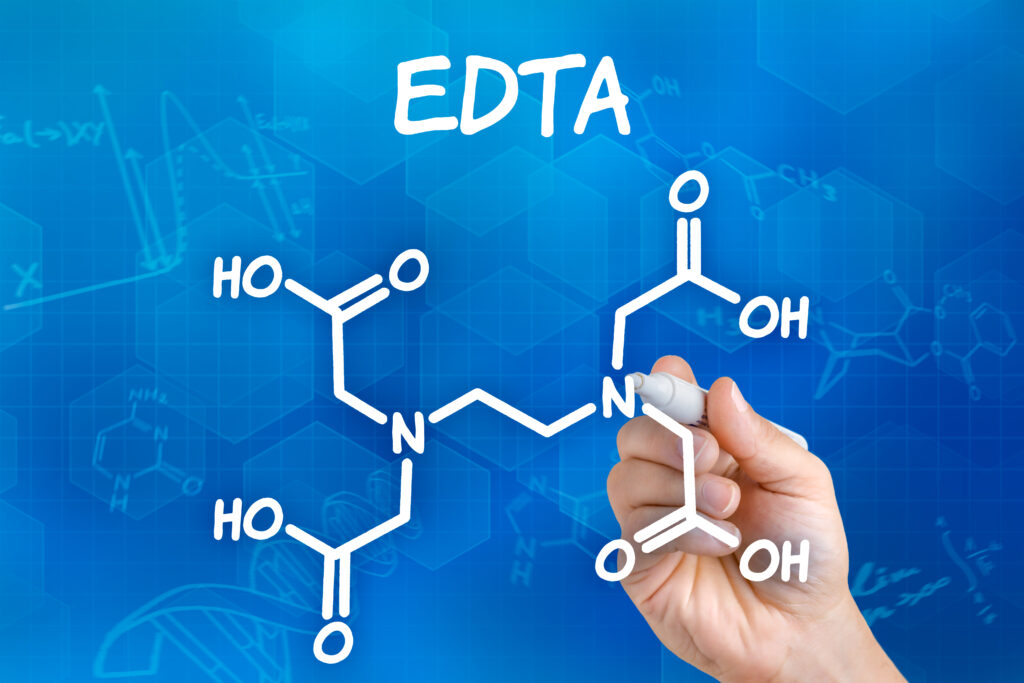Chelation Therapy
How To Use Chelation EDTA Cream
Most people don’t take the time to wonder how many unnatural or dangerous materials that they have in their bodies. It isn’t something you’d usually consider, or actively worry about; that is until you’re faced with the associated health complications. If poisonous metals such as lead, iron, arsenic, and mercury reside in your body for too long, your immune system may suffer greatly, and feel under constant attack. Auto-immune diseases, fatigue, muscle pain and symptoms of anxiety and depression are only a few of the issues that could arise due to the presence of these toxic materials.
Ethylenediaminetetraacetic acid (EDTA) chelation therapy is used to remove these harmful molecules from your bloodstream through a variety of methods, such as oral, intravenous (IV), rectal, and topical. Many doctors who have practiced EDTA therapy with their patients rave about its significant and lasting effects. (1) (2) (3)
Some of the conditions for which EDTA chelation therapy has been suggested as a potential treatment for include:
- Heart Disease
- Anxiety and Depression
- Alzheimer’s Disease
- High Blood Pressure
- High Cholesterol (3) (4)
It is important, however, to consider all angles and to weigh the pros and cons of chelation therapy. In a 2005 research review published by BMC Cardiovascular Disorders, scientists concluded that high-quality evidence for such treatments and results is lacking, and requires further investigation. They also outlined the risks of patients undergoing certain methods, such as intravenous, which brings about an important question: which therapy technique is the most beneficial, safe, and effective?
While each method has its own risks and benefits, topical chelation EDTA cream is highly regarded as the gentlest choice. (5)
Chelation EDTA Cream: How To Use
Topical chelation creams and gels are thought to remove toxic metals by delivering Calcium Disodium into your body. In using a transdermal approach, chelation cream poses much less of a risk than other therapy practices. Overdosing on EDTA is a common worry, and the process needs to be observed very carefully and precisely. Various health risks, such as kidney failure, could arise if every step isn’t monitored well. The use of chelation cream allows for more peace of mind and control when applying. A 2013 research paper, published by the International Journal of Pharmaceutical Investigation, revealed that EDTA cream can be used without risking irritation to the skin, and posited that it can effectively remove radiological contaminants from the body. However, further research into the cream’s potency is necessary. (6) (7) (8)
Patients are often drawn to the topical method more than to others, due to its easy, timely, and accessible nature. Unlike intravenous therapy, which can take up to three hours at a time, you can apply the cream quickly and effortlessly at any time of the day. It can supposedly be rubbed into various body parts, including the prostate and reproductive areas. Due to its gentle nature, it’s important to note that it will take approximately six applications for it to reach the same level of effectiveness as IV. However, you’ll most likely be bypassing several health risks that the other therapies present. Following the application directions carefully and clarifying the correct dose with your doctor are two major steps in using the cream properly. (6) (9) (10)
Potential threats from other methods may include:
- Skin rashes from IV
- The discomfort and potential infections associated with rectal suppositories
- Digestion issues from oral consumption
What Causes Heavy Metal Poisoning?
It is important to understand treatments that may affect our bodies negatively, and how metal poisoning can occur. It isn’t as simple as being exposed to harmful chemicals, such as inhaling polluted air or water. Unfortunately, many household items contain traces of dangerous metals. The foods and medicines we digest can also be the culprits. (11) (12)
The following metals can be found in various substances, including but not limited to:
- Arsenic: Treated woods, certain beers, cosmetics, and rice.
- Cobalt: Hair dyes, tires, and batteries.
- Copper: Jewelry, some birth control, and dental alloys.
- Mercury: Eye drops, body powder, paints, and nasal sprays. (13)
In Conclusion
Removing poisonous substances from our bodies is an emerging practice that’s believed to help people maintain good health. EDTA chelation therapy is the recommended route to take in achieving this goal, and the process is made easy through topical creams and ointments. Other methods include intravenous, rectal, and oral. EDTA chelation cream, however, has been regarded as the gentler choice and avoids the risks of overdose, skin irritation, and infection. It is easy and simple to use and can be applied a few times a day to various parts of the body.
While the effectiveness of creams and gels compared to other practices is still under research, it is considered to be the least invasive treatment. Always remember, however, that before starting any kind of chelation therapy, it’s important to speak to your doctor first and to understand all the potential risks involved.
References:
- “Chelation Therapy from the New Age Journal article by Judith Glassman”, Source: Chelation Therapy from the New Age Journal article by Judith Glassman – Port Townsend, WA & Kirkland, WA (drjonathancollin.com)
- “Chelation”, Source: Chelation | Therapy | Treatments | Hoffman Center | DR. RONALD HOFFMAN (drhoffman.com)
- “Detox with Chelation Therapy – Help Your Heart & Brain”, Source: Chelation Therapy for Heavy Metal Toxicity and More – Dr. Axe
- “What Is Chelation Therapy?”, Source: What You Need to Know About Chelation Therapy (verywellhealth.com)
- “EDTA chelation therapy for cardiovascular disease: a systematic review”, Source: EDTA chelation therapy for cardiovascular disease: a systematic review | BMC Cardiovascular Disorders | Full Text (biomedcentral.com)
- “EDTA Skin Cream For Heavy Metal Detoxification”, Source: EDTA Skin Cream For Heavy Metal Detoxification – Earther Academy
- “EDTA”, Source: EDTA: Uses and Risks (webmd.com)
- “Skin decontamination cream for radiological contaminants: Formulation development and evaluation”, Source: Skin decontamination cream for radiological contaminants: Formulation development and evaluation (nih.gov)
- “EDTA Chelation and the Removal of Toxic Metals”, Source: EDTA Chelation: The Latest Breakthrough In The Removal Of Toxic Metals (drlamcoaching.com)
- “EDTA CHELATION THERAPY”, Source: Get Started – Kelacream
- “What Is Heavy Metal Poisoning? Symptoms, Causes, Diagnoses, Treatment, and Prevention”, Source: What Is Heavy Metal Poisoning? Symptoms, Causes, Diagnosis, Treatment, and Prevention | Everyday Health
- “What Does Chelation Therapy Treat?”, Source: Chelation Therapy: EDTA and Other Chemicals, Benefits, Side Effects (healthline.com)
- “Guide to Sources and Symptoms of Toxic Metals”, Source: Guide to Sources and Symptoms of Toxic Metals – Myersdetox.com

